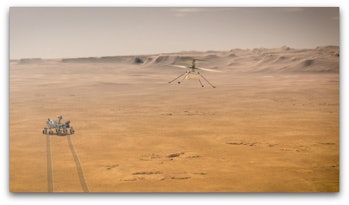The Mars helicopter will conduct the first test flight on another planet.
Following a near-seven month journey through space, NASA's Perseverance rover has finally landed on its target destination Mars on Thursday.
However, the SUV-sized robot did not travel by itself. Perseverance is joined by a smaller, more agile companion: the Ingenuity helicopter. If all goes well, Ingenuity could be the first aircraft to fly on another planet.
Ingenuity is only 19 inches tall, with two four feet long carbon-fiber rotors spinning in opposite directions. It's so small, in fact, that it spent the duration of the trip to Mars tucked inside the bottom of the Perseverance rover.
The team behind Ingenuity are not yet sure whether it is even possible for a helicopter to hover above the Martian surface. Mars' atmosphere is less than one percent the density of Earth’s, so it may be too thin for the helicopter to successfully fly. If it succeeds, then space agencies can add aerial exploration of Mars to future missions.
"The thing that has me the most excited as the NASA administrator is getting ready to watch a helicopter fly on another world," former NASA Administrator Jim Bridenstine said during a press conference that previewed the mission on June 17. "That's something that's never been done before in human history, and here we are."

How will Ingenuity fly on Mars?
The team behind Ingenuity won’t get to test out the helicopter until at least a month after the pair have landed on Mars.
Shortly after their landing, the shield covering will drop and Ingenuity will separate from its robotic companion. After it detaches itself from the rover, the team on the ground has to ensure that Ingenuity passes a few initial milestones before they launch its first test flight. Ingenuity is powered through solar panels that charge up its lithium-ion batteries for one 90-second flight per Martian day.
Once the helicopter is able to charge itself through its solar panel, and communicate with the team through the Mars Helicopter Base Station on the rover, then they can begin testing the helicopter's flight abilities. But that likely won't happen until at least a month after landing on Mars.
Over the course of 30 Martian sols (a sol, the equivalent of a day, on Mars is about 40 minutes longer than a day on Earth), a team of NASA engineers on the ground will test out Ingenuity's ability to fly. But they're going to take things slow.
"We don’t have hard specific dates right now because the Perseverance and Ingenuity teams need time to check their robots and we cannot totally predict how long that will take," Jia-Rui Cook, supervisor of news events and projects at NASA's Jet Propulsion Laboratory, tells Inverse.
For its first flight, the helicopter will take off a few feet off the ground and hover in the air for around 20 to 30 seconds. Although brief, those first seconds of flight will be a major milestone in space exploration. Subsequent flights will attempt further distances and higher altitudes than the one before it. The helicopter could fly for up to 90 seconds, to distances of almost 980 feet at a time and about 10 to 15 feet above the ground.
Once it does take off, NASA engineers will have not only proven that they can fly an aircraft on another planet, one that has a vastly different atmosphere than Earth, but will then get to work deploying more helicopters to Mars and perhaps other worlds — including a plan to send a drone to Saturn’s moon Titan.
https://youtu.be/vnH4yD0s8QM

No comments :
Post a Comment